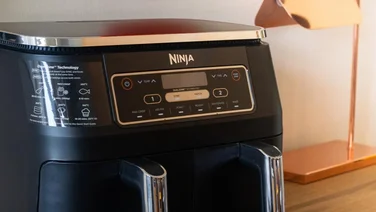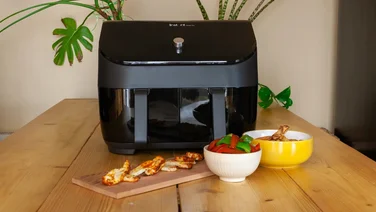To help us provide you with free impartial advice, we may earn a commission if you buy through links on our site. Learn more

In the decade since their introduction, air fryers have become a staple appliance in many homes. This isn’t surprising given their many benefits, from speedy cooking, reduced oil consumption and energy efficiency, for example. What’s more, the best air fryers can be incredibly versatile, offering the ability to cook up a three-course dinner of “fried” starters, roasted mains and even a baked dessert.
While this plethora of possibilities is exciting, if you’re not quite sure how the appliance works or what it’s best used for, it can prove daunting as well. Whether you’re doing some pre-purchase research, have recently ticked an air fryer off your wishlist or just want to boost your knowledge, our guide provides all you need to know to use an air fryer safely and effectively.
How do air fryers work?
Air fryers work much like convection fan ovens, heating air and rapidly circulating it around your food. Adding oil to the equation causes the Maillard reaction to take place, where food develops that mouthwatering, crisped browned surface.
What foods can I cook in an air fryer?
A basket of perfectly golden chips might be the first thing that comes to mind when you picture air fryer cooking, but the possibilities extend far beyond frozen carbs. The average air fryer will enable you to cook a range of foods, from fish and tofu, to eggs and even cake. It’s also worth exploring your appliance’s settings: even the most basic Ninja air fryer offers options for roasting, dehydrating and reheating, for instance.Of course, there are some foods better cooked in the other appliances in your kitchen. Save the popcorn for a popcorn maker, for example, since the kernels can become lodged in the heating element of an air fryer, posing a fire risk. Cheese can burn, broccoli will taste far better cooked in a steamer, and runny foods and liquids such as pasta sauces and batters are likely to make a mess and, again, can pose a fire risk if they come into contact with the heating element.
How to use the most common air fryer settings?
Many air fryers come with multiple cooking functions. Not all models will have the same presets, but the following are the most common:
Air fry – The default function of the air fryer, it’s ideal for a variety of foods from meat to potatoes, vegetables and more. It offers a flexible temperature range.
Bake – The setting for cakes, pastries, breads and other batters that are cooked in the air fryer in baking dishes.
Dehydrate – This function heats foods at low temperatures over a few hours to remove moisture. Perfect for homemade dried fruit, vegetable crisps or beef jerky.
Grill – Grilling employs direct top-down heating at higher temperatures to cook foods such as steaks or kebabs, for example.
Roast – The ideal setting for roasting meat, potatoes and vegetables. Offers a flexible temperature range.
Reheat – Works at lower to medium temperatures to warm up leftovers such as pizza, without drying them out or making them soggy.
READ NEXT: Best small air fryers
How to use an air fryer
1. If recommended by the manufacturer of your model, preheat your air fryer for the time suggested.
2. Arrange food on the trays or baskets in a single layer. Don’t load baskets past the maximum suggested quantity; overfilling will stop the hot air from circulating properly, resulting in soggy, unevenly cooked food.
3. Add some oil, if you want. For crispier results, a tablespoon of oil or a light coating of cooking spray is recommended. However, we recommend you avoid spraying the cooking basket itself with oil, as this can cause burning.
4. Choose the setting, temperature and time as outlined in your particular model’s manual. A rule of thumb when converting from typical oven cooking is to reduce the temperature by 20ºC and the time by 20%, as air fryers heat up faster and the distribution of hot air in their chambers is more efficient.
5. Remember to check on the food throughout the cooking process, especially if you’re new to air frying. Shake or flip it at least once with some silicone-tipped tongs to ensure even cooking and prevent overcooking or burning.
6. Once finished, remove the container carefully and place on a heat-resistant surface.
READ NEXT: Best dual air fryers
How should I clean my air fryer?
Maintaining the interior, exterior and removable parts of your air fryer is important to prevent nasty oil and food build-up. Having used your appliance, let it cool completely before giving it a clean.

To do this, unplug your air fryer and take out all the removable parts – such as baskets and trays. The majority will be dishwasher-safe, but you can also give them a gentle scrub with a non-stick sponge dipped in warm, soapy water. Don’t forget to wipe the interior of your air fryer, including the heating element, as well as the exterior with a damp cloth.
READ NEXT: How to clean an air fryer
What else do I need to know about using an air fryer?
Capacity
If you’re yet to purchase an air fryer, consider how you’ll be using the appliance and buy accordingly. For snacks and occasional treats, a small air fryer will do. If you’re planning to cook whole meals, then a dual air fryer will be a better option.
Ventilation
Keep your air fryer a good distance away from the wall during cooking. The appliance needs space around it to prevent it from overheating.
Liners
If you want to cut down on the cleaning, try lining your basket with perforated parchment paper.






